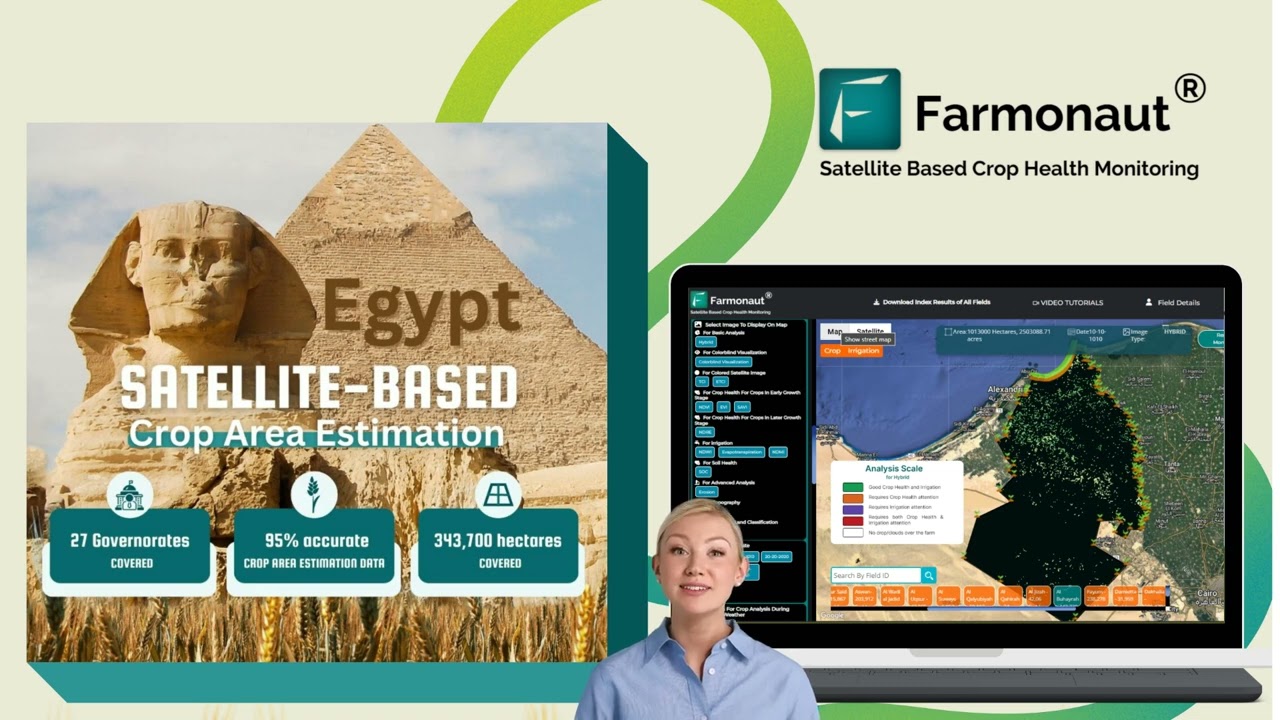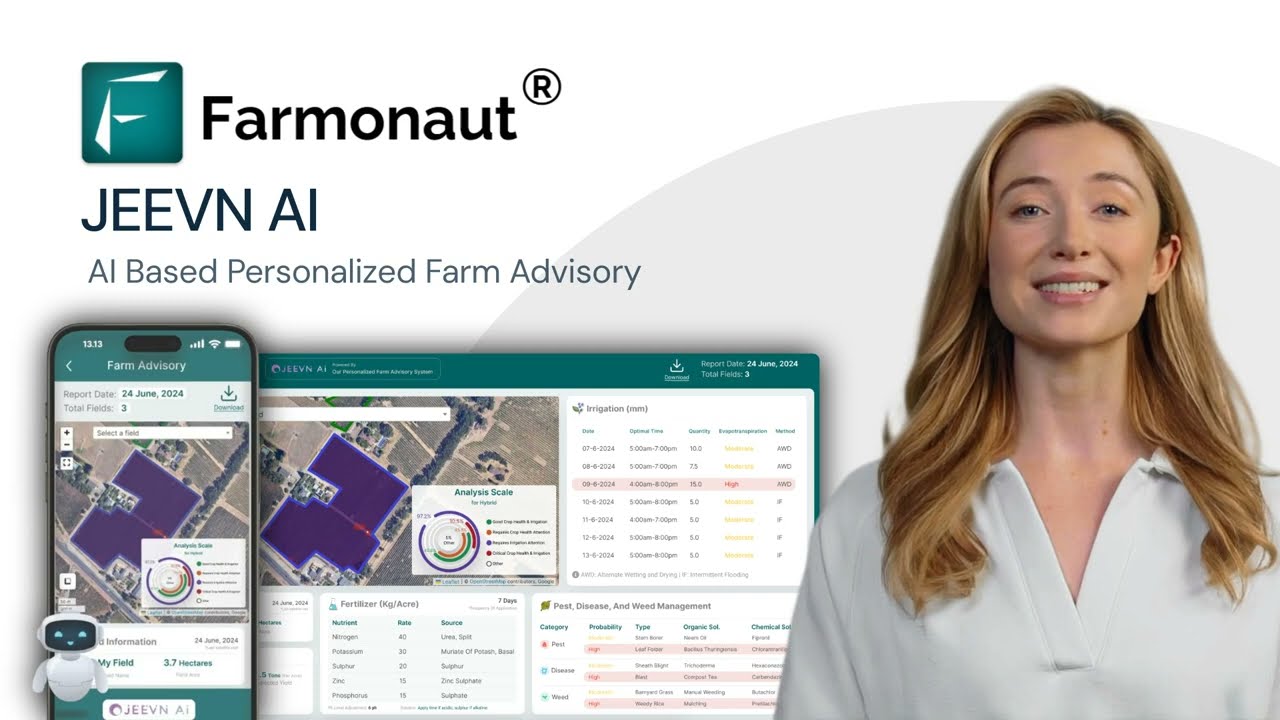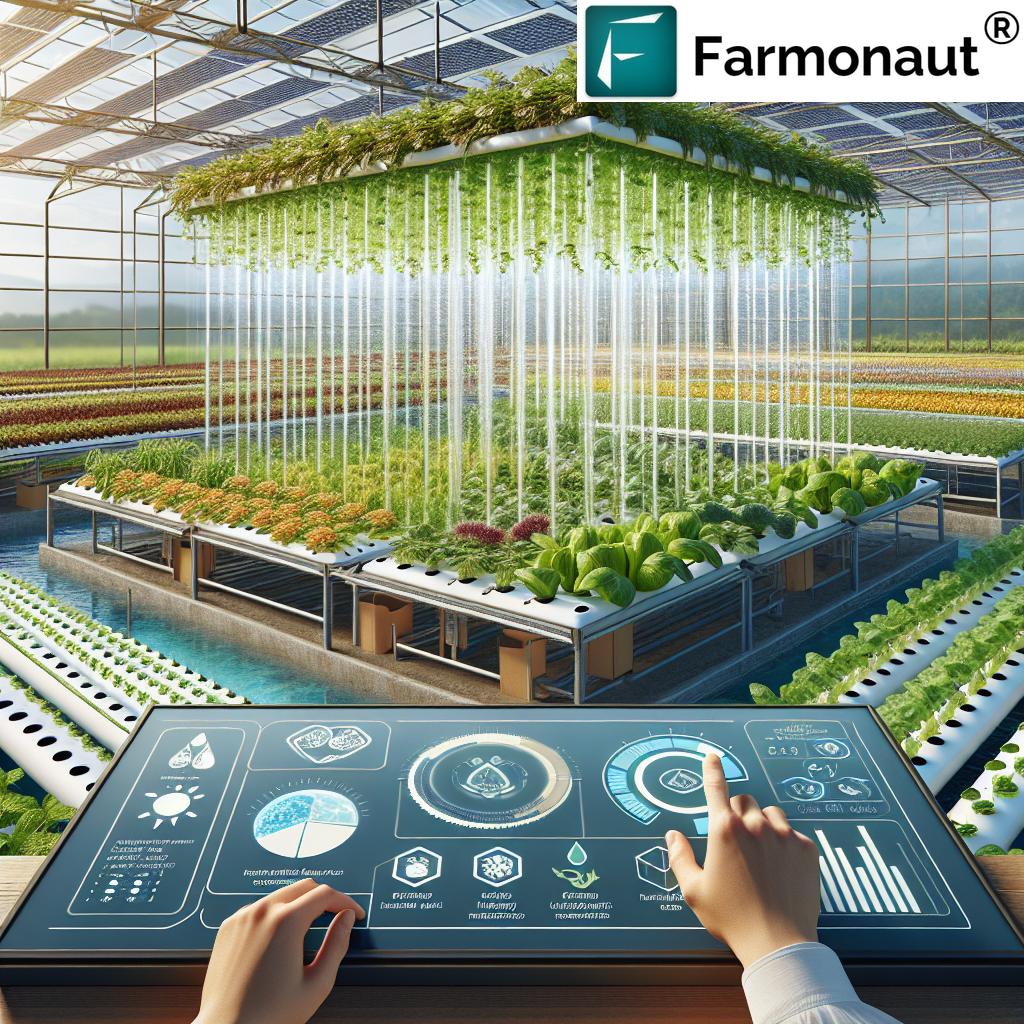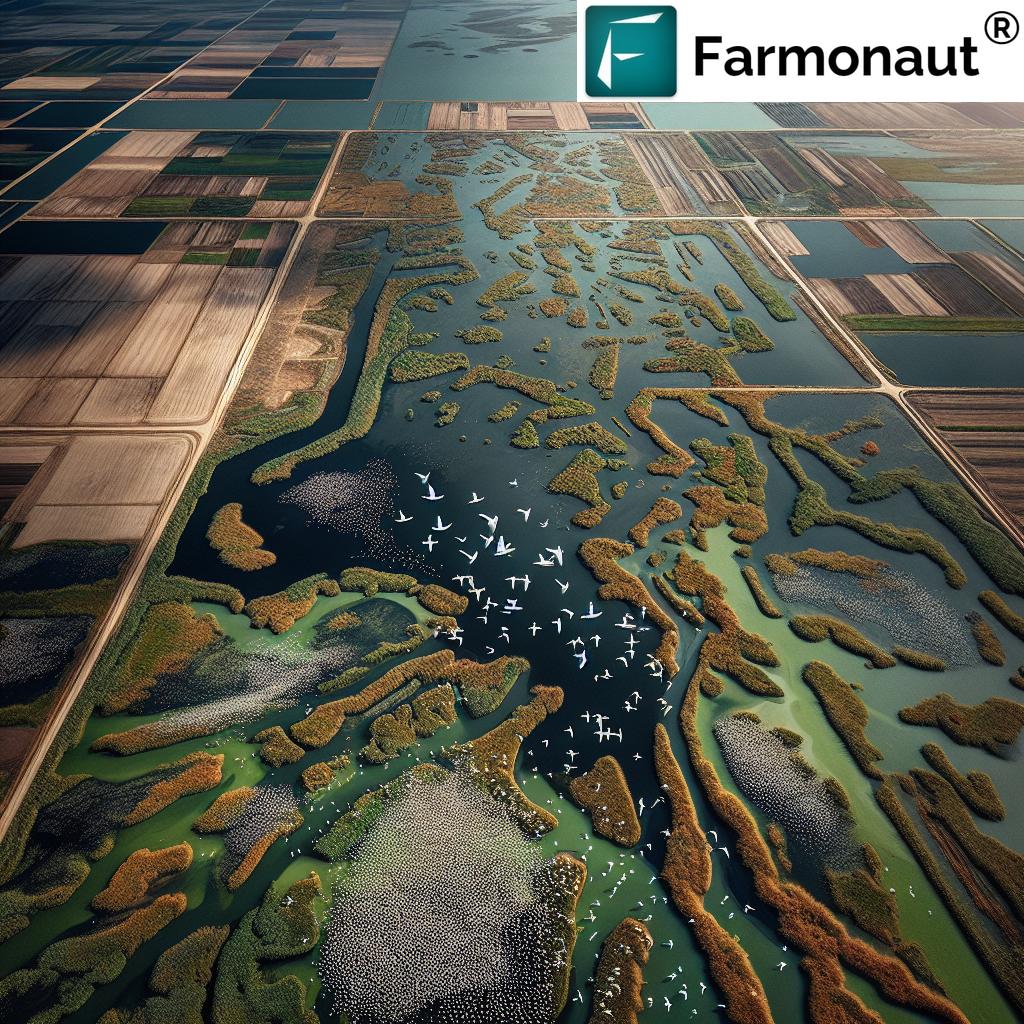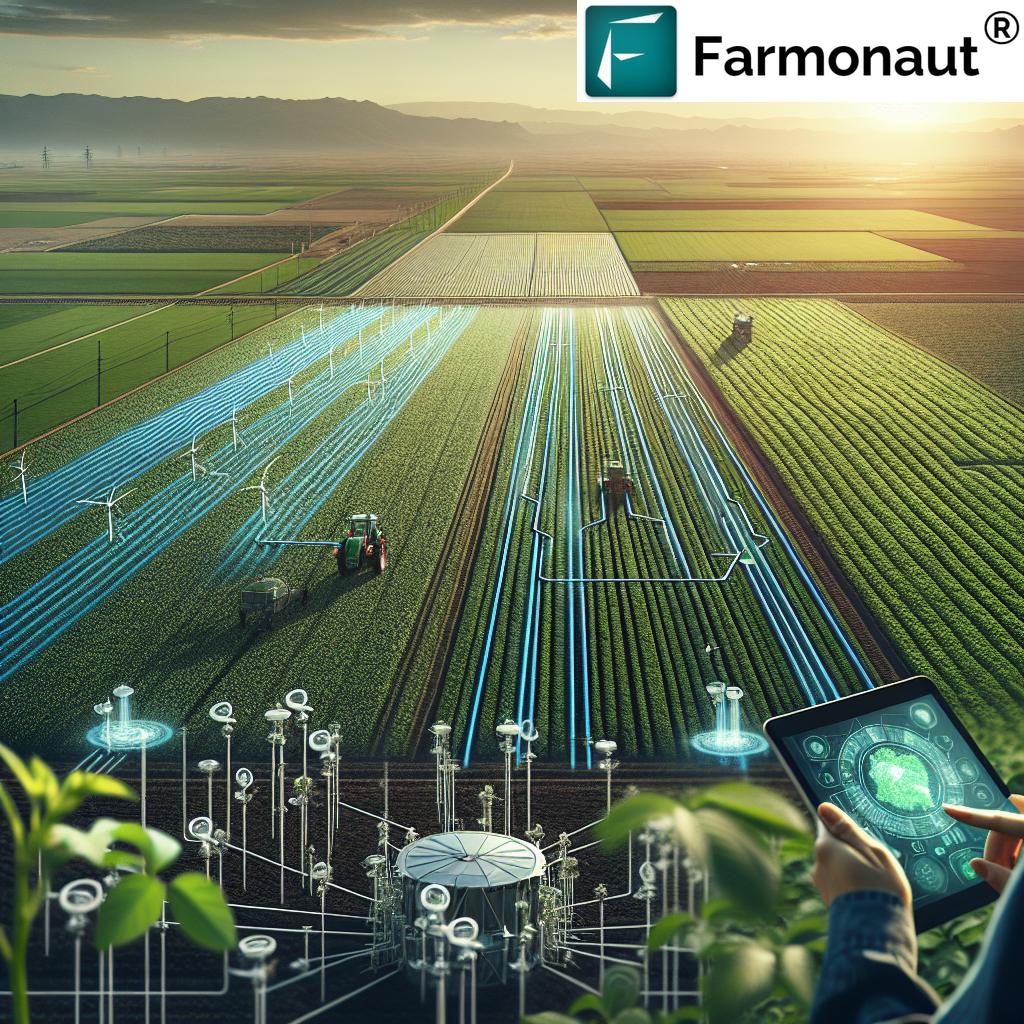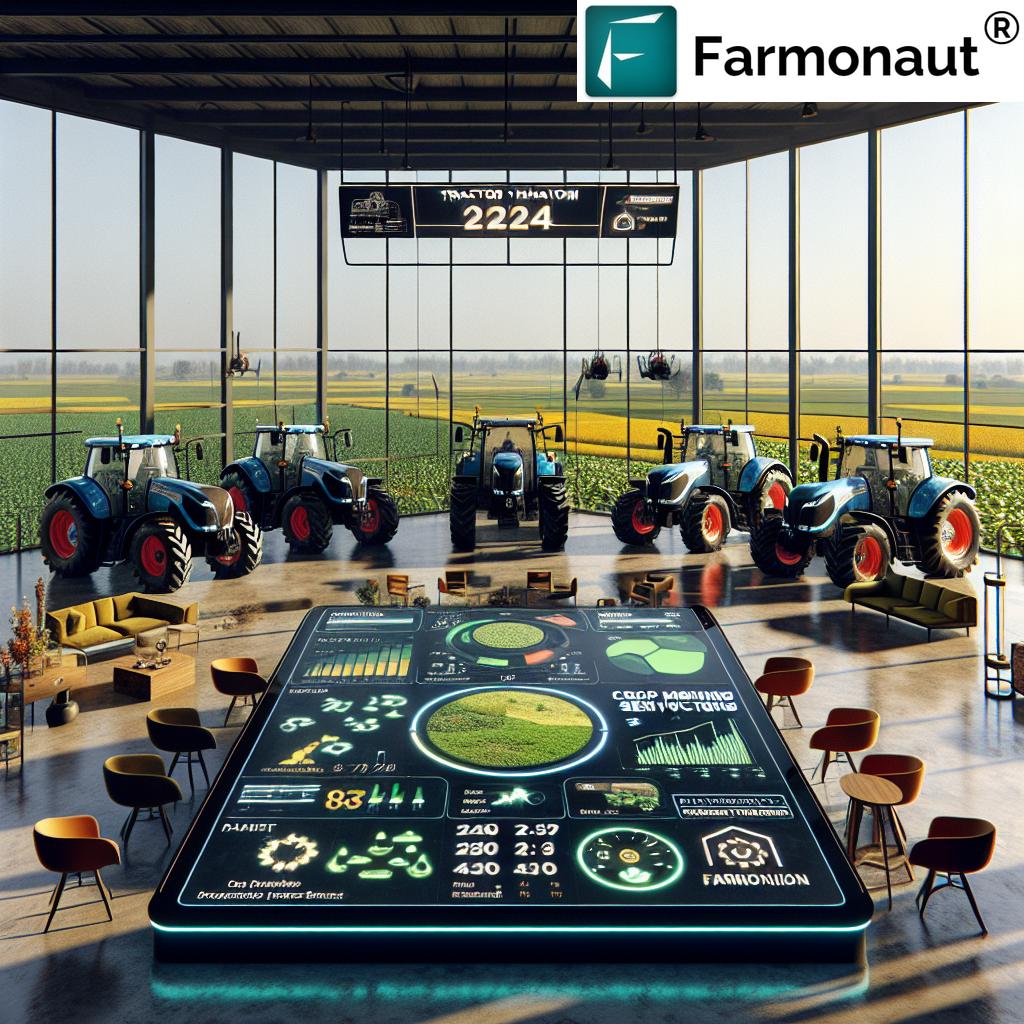Agricultural Technology Advancements: 10 Top Indian Trends
“Precision agriculture adoption in India has increased by 35% since 2020, revolutionizing farm management and resource efficiency.”
Table of Contents
- Introduction: Technology Transforming Indian Agriculture
- 1. Precision Agriculture
- 2. Autonomous Farming Machinery
- 3. Agrivoltaics: Crop & Solar Integration
- 4. Vertical Farming and Hydroponics
- 5. Blockchain in Agriculture Supply Chain
- 6. Smart Irrigation Systems
- 7. Regenerative Agriculture Practices
- 8. AI in Crop Monitoring and Machine Learning
- 9. IoT-Enabled Smart Greenhouses
- 10. Robotic Harvesters for Delicate Crops
- Comparative Feature & Impact Table
- Challenges and Considerations
- Farmonaut’s Role: Driving Technology for Indian Agriculture
- FAQ: Indian Agricultural Technology Advancements
- Conclusion: The Future of Indian Farming
Introduction: Technology Transforming Indian Agriculture
Agriculture in India is undergoing a remarkable transformation driven by advanced technologies and innovative solutions. From precision agriculture and smart irrigation systems to vertical farming and hydroponics, farmers are leveraging new tools to address challenges like resource constraints, climate variability, and labor shortages. These agricultural technology advancements are boosting yields, improving sustainability, and enhancing resilience for both smallholders and large agribusinesses alike.
In this comprehensive guide, we explore the top 10 Indian trends in agri-tech shaping the future of farming. We’ll examine the technologies at the forefront of crop production, soil health, water management, and supply chain transparency—detailing how innovations such as autonomous farming machinery, AI in crop monitoring, and blockchain in agriculture supply chain are revolutionizing Indian agriculture from the ground up.
1. Precision Agriculture: The Engine of Modern Indian Farming
Enhancing Soil, Crop, and Resource Management with Technology
Precision agriculture represents a paradigm shift in how farmers manage their soil, crops, and resources. By harnessing the power of GPS, IoT sensors, data analytics, and satellite imagery, this approach empowers farmers to make informed decisions regarding irrigation, fertilization, pest management, and more. The results? Reduced resource waste, lower costs, enhanced efficiency, improved crop health, and maximized yields.
In India, the adoption of precision agriculture has seen a significant rise, particularly as climate change and unpredictable weather patterns impact rural and smallholder agriculture. These technologies not only optimize the use of water, fertilizer, and labor, but also provide actionable insights via tools like AI-powered weather forecasting. This enables even resource-constrained farmers to increase climate resilience, achieve greater savings, and reduce debts.
- Real-time soil monitoring ensures crops receive the right nutrients at the right time, preventing excessive fertilizer use.
- Satellite imagery and computer vision help in analyzing crop vigor, spotting pest outbreaks, and diagnosing problems early.
- The integration of AI further amplifies productivity through data-driven advisory systems.
For cost-effective, scalable precision agriculture solutions, we at Farmonaut utilize satellite-based crop health monitoring, soil moisture analytics, and AI-driven advice on our accessible mobile, web, and API platforms.
Explore Farmonaut’s Carbon Footprinting solution to track your environmental impact in real-time and enhance sustainability efforts.
2. Autonomous Farming Machinery: Efficiency Meets Innovation
Advanced Machines for Planting, Tilling, and Harvesting
With growing labor shortages in Indian agriculture, autonomous farming machinery offers a highly effective solution. Modern tractors, planters, and harvesters embed computer vision, AI, and machine learning to navigate fields, detect obstacles, and perform tasks with minimal human intervention.
Major companies have introduced autonomous tractors capable of planting, tilling, and even harvesting crops. Specialized robotic machinery is also emerging for pruning and delicate work in orchards and vineyards, ensuring precision and reducing potential crop or resource waste.
- Increased efficiency: Machines can operate for longer hours and in difficult weather or soil conditions where manual labor is limited.
- Reduced labor costs: Automation reduces dependency on seasonal or migrant workers.
- Enables data collection during field operations, providing actionable analytics to further optimize farming systems.
Autonomous machinery is a game-changer for both large-scale agribusinesses and progressive individual farmers seeking cost savings and higher yields while facing manpower constraints.
See how Farmonaut’s Fleet Management tools optimize machinery usage for agri-logistics and reduce operational costs for Indian farmers.
3. Agrivoltaics: Combining Crop and Solar Energy Production
Efficiency on Every Inch of Indian Farmland
Agrivoltaics introduces an innovative system for the simultaneous production of crops and renewable solar energy on the same piece of land. By installing solar panels above fields or between crops, farmers can generate off-grid energy, benefit from shading that reduces water consumption, and diversify their income streams.
This trend is particularly beneficial in sun-abundant but arid regions of India, helping protect crops from extreme weather and maximizing land use efficiency—with studies showing an increase up to 60–70%. Agrivoltaics reduces water evaporation and improves resilience against climate impact while supporting sustainable farming goals.
- Dual income from food and solar energy production
- Improved soil moisture retention and reduced irrigation needs
- Minimization of environmental impact compared to monoculture use of land
Agrivoltaics projects are increasingly being adopted by progressive Indian farmers and institutional cultivators looking to balance production and sustainability.
4. Vertical Farming and Hydroponics: Urban Agriculture for the Future
Maximizing Yields in Densely Populated Indian Cities
Rapid urbanization in India has led to the widespread emergence of vertical farming and hydroponics. These sustainable farming solutions allow for intensive cultivation in stacked layers—indoors, in greenhouses, or on rooftops—using soil-less nutrient solutions and advanced LED lighting systems.
Key benefits for Indian farmers and food entrepreneurs:
- Significant reduction in land usage: Grow more crops in less area, ideal for cities like Mumbai, Delhi, and Bengaluru.
- Water savings up to 90%: Sophisticated recirculation systems manage water usage efficiently.
- Year-round production: Controlled climate and lighting systems enable growers to avoid seasonal losses from extreme weather.
- Fresher produce: Local cultivation reduces transportation costs and emissions, delivering higher-quality food to consumers.
Vertical farming and hydroponics are unlocking new opportunities for entrepreneurs and farmers willing to invest in advanced infrastructure, especially targeting urban demand for premium, residue-free produce.
Discover Farmonaut’s Large-Scale Farm Management app—streamline operations in hydroponics or vertical farms and monitor performance using satellite and AI analytics.
“AI-powered crop monitoring tools now analyze over 2 million hectares of Indian farmland for real-time health and yield insights.”
5. Blockchain in Agriculture Supply Chain: Traceability & Trust
Ensuring Quality, Food Safety, and Transparency
Global and domestic consumers are increasingly demanding supply chain transparency and proof of food quality. Blockchain technology offers a reliable solution by creating immutable, transparent records of every stage in the food supply chain—from farm to marketplace.
- Traceability: Verify the origin and journey of crops (such as basmati rice, mangoes, or organic cotton) for premium Indian exports and local markets.
- Reduces fraud and ensures compliance with export and domestic food safety standards.
- Builds consumer trust, fostering brand reputation and loyalty.
The integration of blockchain is rapidly becoming standard for high-value crops and agricultural products, empowering both smallholders and corporate supply chains in India.
Learn about Farmonaut’s Blockchain-Based Product Traceability solution, which adds transparency and accountability across diverse agri supply chains.
6. Smart Irrigation Systems: Optimizing Water Use in Indian Fields
IoT, Sensors, and Data Analytics for Resource Management
In a country where water scarcity is a persistent challenge, smart irrigation systems are revolutionizing how Indian farmers manage this essential resource. These IoT-enabled systems combine sensors, weather forecasting, and real-time soil moisture monitoring to deliver just the right amount of water to crops—no more, no less.
- Maximize water efficiency—vital for crops in arid zones or drought-prone regions of Maharashtra, Gujarat, and Rajasthan.
- Reduce input costs and prevent waste through precise, automated irrigation schedules.
- Boost crop health and yields while minimizing labor and operational complexity.
At Farmonaut, we offer satellite-driven soil moisture analytics and IoT integration to help farmers monitor fields and automate irrigation, making water conservation achievable even for smallholder farmers.
Access Farmonaut’s API for seamless integration of satellite and weather data into your irrigation systems, or check our developer docs for implementation support.
7. Regenerative Agriculture Practices: Soil Health, Carbon, and Biodiversity
Restoring Indian Fields with Sustainable Techniques
With mounting concern over soil degradation and loss of biodiversity, regenerative agriculture practices are gaining ground among Indian growers. These techniques—including crop rotation, cover cropping, reduced tillage, and organic amendments—seek to restore the ecosystem, sequester carbon, and enhance soil health for the long term.
- Improve natural fertility and resilience through biological soil management.
- Increase carbon sequestration, supporting both food security and climate action goals.
- Protect against drought and flood damage by rebuilding organic matter and root systems.
These sustainable farming methods are critical for Indian farmers looking to comply with new environmental regulations and access carbon credit markets.
Measure your farm’s carbon footprint and environmental impact—our platform provides insights to help you optimize resource use while pursuing regenerative agriculture.
8. AI in Crop Monitoring & Machine Learning: Smarter, Predictive Decision-Making
Proactive Monitoring, Analytics, and Risk Management
Artificial Intelligence (AI) and machine learning have become linchpins in today’s crop monitoring, yield prediction, and risk management strategies. AI-powered tools rapidly analyze large datasets—from satellite imagery to sensor readings—to predict disease outbreaks, assess crop health, and provide targeted management advice.
- Predictive analytics: Anticipate threats and yield fluctuations, helping farmers plan interventions with maximum cost efficiency.
- Disease and pest detection: Computer vision systems identify early signs of stress, allowing for precise, targeted control.
- Environmental monitoring: Track pollution, biodiversity, and ecosystem changes to ensure long-term sustainability and compliance.
We at Farmonaut leverage AI and machine learning technologies, offering farmers real-time advisory and actionable insights—empowering smarter decision-making at every stage of the crop cycle.
Try Farmonaut’s crop, soil, and weather monitoring for data-driven farm management on Android, iOS, or browser.
9. IoT-Enabled Smart Greenhouses: Controlled Environments for Maximum Yields
Automated Operations & Cost Savings in Indian Floriculture and Horticulture
As pressure mounts to produce more food sustainably, IoT-enabled smart greenhouses offer Indian growers a way to shield crops from unpredictable weather while maximizing production efficiency. These systems combine temperature, humidity, light, and soil sensors with AI-powered climate control and resource management tools.
- Precision monitoring of all growing conditions, leading to optimal yields and reduced input costs.
- Automated alerts and decision-support analytics enable proactive management of greenhouse operations.
- Improved energy and water use efficiency, supporting sustainability and profitability.
IoT-driven smart greenhouses are rapidly being adopted for high-value crops in states like Tamil Nadu, Karnataka, and Himachal Pradesh.
Farmonaut’s Crop & Plantation Advisory tools help optimize performance in commercial greenhouses, offering actionable insights with satellite and AI data.
10. Robotic Harvesters for Delicate Crops: Automation for Higher Quality and Less Waste
Next-Gen Solutions for Indian Horticulture
The latest in agricultural robotics, robotic harvesters now harness computer vision and AI to detect, pick, and sort delicate crops—such as tomatoes, strawberries, or floriculture products in Indian markets.
- Labor shortage solutions: Robots operate alongside human teams or autonomously, ensuring timely harvests even during labor crises.
- Minimal crop damage: Advanced gripping and sorting systems handle produce gently, reducing losses and preserving quality for higher market prices.
- Computer vision ensures each fruit is harvested at peak ripeness and sorted by quality tickets, boosting farmer revenue.
With further improvements in costs and reliability, robotic harvesters are poised to become standard equipment in India’s high-value horticulture and specialty crop industries.
Farmonaut’s Crop Loan and Insurance verification tools help secure financial stability for growers embracing advanced harvest automation.
Comparative Feature & Impact Table: Top 10 Agricultural Technology Advancements in India
This comparative table summarizes key features, estimated impact, and adoption of each agri-tech trend, supporting smarter choices for Indian farmers and agri-entrepreneurs.
| Trend | Description | Key Technologies Used | Estimated Yield Improvement (%) | Estimated Cost Savings (%) | Environmental Impact | Current Adoption Rate in India (%) |
|---|---|---|---|---|---|---|
| Precision Agriculture | Optimization of input usage via real-time data to increase efficiency and yields. | GPS, IoT Sensors, Satellite Imagery, Data Analytics, AI | 15–25 | 10–20 | Reduces waste, improves soil & water health | 35 |
| Autonomous Farming Machinery | Automated tractors & robots for planting, tilling, and harvesting. | AI, Computer Vision, Machine Learning | 12–20 | 15–25 | Lower energy use, reduced labor input | 7 |
| Agrivoltaics | Integration of solar panels & crop production on the same land. | Solar Panels, Land Management Systems, Sensors | 10–18 | 12–30 | Reduces water loss, renewable energy generation | 2–3 |
| Vertical Farming & Hydroponics | Urban, soil-less cultivation using nutrient solutions & lighting. | Hydroponics, LED Lighting, Climate Controls | 20–30 | 18–25 | Minimizes land & water consumption | 1.5 |
| Blockchain in Supply Chain | Immutable, transparent digital pedigree for food safety and quality. | Blockchain, Data Ledgers, QR Codes | 3–7 | 5–10 | Reduces fraud, increases consumer trust | 8 |
| Smart Irrigation Systems | Automated delivery based on soil moisture, weather, and crop needs. | IoT Sensors, AI Forecasting, Data Analytics | 12–18 | 17–30 | Major water savings, limits run-off | 17 |
| Regenerative Agriculture | Soil-restoring practices that improve biodiversity and resilience. | Crop Rotation, Cover Cropping, Minimal Tillage | 10–15 | 8–16 | Sequesters carbon, restores soil/land | 11 |
| AI in Crop Monitoring | Machine learning and analytics for proactive decision support. | AI, Satellite & Aerial Imagery, Sensors | 10–20 | 12–18 | Reduces chemical/pesticide usage | 14 |
| IoT-Enabled Smart Greenhouses | Automated controlled environments for protected cultivation. | IoT Sensors, Climate Control, AI | 15–28 | 18–28 | Improves energy/labor efficiency | 3 |
| Robotic Harvesters | Computer-vision powered robots for picking and sorting delicate crops. | Robotic Arms, Computer Vision, AI | 7–14 | 15–22 | Minimizes harvest damage & losses | 2 |
Challenges and Considerations in Indian Agri-Tech Adoption
Despite the promise of these agricultural technology advancements, several challenges need to be addressed for widespread adoption in India:
- High initial costs: Adoption may be constrained for resource-limited smallholder farmers and rural agri-communities.
- Technical complexity: Automation, IoT, and AI require training and support to be effective for non-tech-savvy users.
- Data privacy and security: Ensuring the security of agricultural data and protecting farmer privacy are growing concerns in the digital age.
- Labor displacement: Automation could reduce employment opportunities for manual laborers; targeted upskilling is essential.
- Digital divide: Equitable access—especially in remote, unconnected regions—is a key policy consideration.
- Energy and infrastructure: Reliable power and connectivity are prerequisites for IoT and AI-based solutions.
Overcoming these obstacles requires collaborative action among technology providers, agri-institutions, government agencies, NGOs, and—most importantly—the farmers themselves.
Farmonaut’s Role: Driving Technology for Indian Agriculture
We at Farmonaut are committed to making precision agriculture accessible and affordable for Indian farmers of all scales. Our integrated, modular suite of solutions empowers everyone—from smallholders to large agribusinesses—to embrace next-generation agricultural technology with confidence and transparency.
- Satellite-based Crop Health Monitoring: Use our mobile and web app to track vegetation vigor, soil moisture, and real-time field conditions for smarter farm management.
- Jeevn AI Advisory System: Get custom agronomic advice and predictive analytics for optimal decisions on irrigation, fertilization, and pest control.
- Blockchain-Based Traceability: Ensure product supply chain transparency with secure, verifiable records from farm to consumer.
- Fleet & Resource Management: Reduce operational costs and maximize machinery efficiency by integrating our fleet tracking solution.
- Carbon Footprinting & Sustainability: Meet new sustainability targets and tap into green markets by using our emissions monitoring dashboard.
Our flexible subscription-based pricing caters to every segment—individuals, cooperatives, agribusinesses, and public institutions. Platform access is available via Android, iOS, browser, and API (with developer documentation for easy integration).
Empower your farm—experience the latest precision agriculture, AI in crop monitoring, and smart irrigation system capabilities through our carefully designed plans:
Experience the Future of Indian Farm Management with Farmonaut
- Start with our FREE DEMO
- Explore Plantation & Large-Scale Farm Advisory Tools
- Secure Satellite-Verified Crop Loans & Insurance
Frequently Asked Questions: Indian Agricultural Technology Advancements
What is precision agriculture and how is it used in India?
Precision agriculture uses GPS, sensors, satellite imagery, and data analytics to help Indian farmers optimize input usage, improve yield, and reduce resource waste. It’s adopted by both smallholders and large farms for smarter, sustainable production.
How does AI in crop monitoring benefit Indian farmers?
AI-powered crop monitoring offers real-time insights into crop health, early detection of diseases/pests, and yield forecasting. This improves decision-making, reduces input costs, and increases resilience to unpredictable weather conditions and climate change.
What are smart irrigation systems and why are they important?
Smart irrigation systems use IoT, sensors, and weather data to provide precise water to crops only when needed. This saves water, reduces costs, and is especially vital in water-scarce regions of India facing drought or irregular rainfall patterns.
How does blockchain improve supply chain transparency in agriculture?
Blockchain in agriculture supply chain creates tamper-proof records verifying the origin, journey, and quality of produce. This boosts consumer trust, reduces fraud, and ensures exporters/importers meet safety standards—especially for premium Indian agri-products.
Can smallholder farmers afford these advanced technologies?
While initial investment can be high, platforms like Farmonaut make precision agriculture affordable via subscription models and pay-per-use APIs. Adoption is also supported by growing access to smartphones, data connectivity, and targeted government schemes.
Which Indian states are leading in adoption of agricultural tech?
States such as Maharashtra, Punjab, Karnataka, Tamil Nadu, and Gujarat are at the forefront, with strong growth in smart irrigation, precision agriculture, and sustainable farming solutions, supported by progressive policies and agri-tech startup presence.
What support is needed for scaling these solutions nationwide?
Widespread adoption requires financial incentives, on-ground training, infrastructure upgrades, and awareness campaigns. Collaboration between private tech solution providers, NGOs, and government ensures equitable access across India.
Conclusion: The Future of Indian Farming—Smarter, Sustainable, Resilient
The integration of advanced technology in Indian agriculture is not a distant dream—it is happening now. As we’ve seen, the top 10 trends—from precision agriculture and smart irrigation systems to AI-powered crop monitoring and blockchain-based supply chain innovations—are ushering in an era of higher yields, environmental stewardship, and economic resilience for farmers across the country.
By leveraging these innovations, Indian farmers—supported by platforms like Farmonaut—can overcome challenges posed by climate variability, resource constraints, and market volatility. Together, these technology-driven solutions promise to secure food security and a sustainable, profitable future for India’s farms, fields, and forests.
Stay ahead of the curve in Indian agriculture. Monitor your fields, optimize your resources, and unlock your yield potential—all with Farmonaut’s satellite-powered farm management app!




